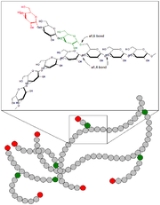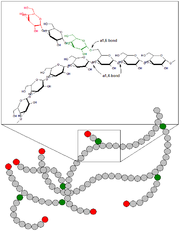
Glycogen branching enzyme
Encyclopedia
A glycogen branching enzyme is an enzyme
that takes part in converting glucose
to glycogen
. It adds branches to the growing glycogen molecule. Glycogen is a branching polymer
of large numbers of glucose
units linked together. The structure is based on chains of glucose units with linkages between carbon
atoms 1 and 4 of each pair of units (alpha 1, 4 linkages). These linkages are catalyzed
by the enzyme glycogen synthase
.
 Every 10 to 14 glucose
Every 10 to 14 glucose
units a side branch with an additional chain of glucose units occurs. The side chain
attaches at carbon atom 6 of a glucose unit, and the linkage is termed an alpha-1,6 glycosidic bond. To form this connection a separate enzyme known as a branching enzyme is used. A branching enzyme attaches a string of seven glucose units to the sixth carbon of a glucose unit, usually in an interior location of the glycogen molecule.
This enzyme belongs to the family of transferase
s, to be specific, those glycosyltransferases that transfer hexose
s (hexosyltransferases). The systematic name of this enzyme class is 1,4-alpha-D-glucan:1,4-alpha-D-glucan 6-alpha-D-(1,4-alpha-D-glucano)-transferase. Other names in common use include branching enzyme, amylo-(1,4→1,6)-transglycosylase, Q-enzyme, alpha-glucan-branching glycosyltransferase, amylose isomerase, enzymatic branching factor, branching glycosyltransferase, enzyme Q, glucosan transglycosylase, 1,4-alpha-glucan branching enzyme, plant branching enzyme, alpha-1,4-glucan:alpha-1,4-glucan-6-glycosyltransferase, and starch branching enzyme. This enzyme participates in starch
and sucrose
metabolism.
and glycogen-branching enzyme deficiency.
has been solved for this class of enzymes, with the PDB
accession code .
Enzyme
Enzymes are proteins that catalyze chemical reactions. In enzymatic reactions, the molecules at the beginning of the process, called substrates, are converted into different molecules, called products. Almost all chemical reactions in a biological cell need enzymes in order to occur at rates...
that takes part in converting glucose
Glucose
Glucose is a simple sugar and an important carbohydrate in biology. Cells use it as the primary source of energy and a metabolic intermediate...
to glycogen
Glycogen
Glycogen is a molecule that serves as the secondary long-term energy storage in animal and fungal cells, with the primary energy stores being held in adipose tissue...
. It adds branches to the growing glycogen molecule. Glycogen is a branching polymer
Polymer
A polymer is a large molecule composed of repeating structural units. These subunits are typically connected by covalent chemical bonds...
of large numbers of glucose
Glucose
Glucose is a simple sugar and an important carbohydrate in biology. Cells use it as the primary source of energy and a metabolic intermediate...
units linked together. The structure is based on chains of glucose units with linkages between carbon
Carbon
Carbon is the chemical element with symbol C and atomic number 6. As a member of group 14 on the periodic table, it is nonmetallic and tetravalent—making four electrons available to form covalent chemical bonds...
atoms 1 and 4 of each pair of units (alpha 1, 4 linkages). These linkages are catalyzed
Catalysis
Catalysis is the change in rate of a chemical reaction due to the participation of a substance called a catalyst. Unlike other reagents that participate in the chemical reaction, a catalyst is not consumed by the reaction itself. A catalyst may participate in multiple chemical transformations....
by the enzyme glycogen synthase
Glycogen synthase
Glycogen synthase is an enzyme involved in converting glucose to glycogen. It takes short polymers of glucose and converts them into long polymers....
.

Glucose
Glucose is a simple sugar and an important carbohydrate in biology. Cells use it as the primary source of energy and a metabolic intermediate...
units a side branch with an additional chain of glucose units occurs. The side chain
Side chain
In organic chemistry and biochemistry, a side chain is a chemical group that is attached to a core part of the molecule called "main chain" or backbone. The placeholder R is often used as a generic placeholder for alkyl group side chains in chemical structure diagrams. To indicate other non-carbon...
attaches at carbon atom 6 of a glucose unit, and the linkage is termed an alpha-1,6 glycosidic bond. To form this connection a separate enzyme known as a branching enzyme is used. A branching enzyme attaches a string of seven glucose units to the sixth carbon of a glucose unit, usually in an interior location of the glycogen molecule.
This enzyme belongs to the family of transferase
Transferase
In biochemistry, a transferase is an enzyme that catalyzes the transfer of a functional group from one molecule to another . For example, an enzyme that catalyzed this reaction would be a transferase:In this example, A would be the donor, and B would be the acceptor...
s, to be specific, those glycosyltransferases that transfer hexose
Hexose
In organic chemistry, a hexose is a monosaccharide with six carbon atoms, having the chemical formula C6H12O6. Hexoses are classified by functional group, with aldohexoses having an aldehyde at position 1, and ketohexoses having a ketone at position 2....
s (hexosyltransferases). The systematic name of this enzyme class is 1,4-alpha-D-glucan:1,4-alpha-D-glucan 6-alpha-D-(1,4-alpha-D-glucano)-transferase. Other names in common use include branching enzyme, amylo-(1,4→1,6)-transglycosylase, Q-enzyme, alpha-glucan-branching glycosyltransferase, amylose isomerase, enzymatic branching factor, branching glycosyltransferase, enzyme Q, glucosan transglycosylase, 1,4-alpha-glucan branching enzyme, plant branching enzyme, alpha-1,4-glucan:alpha-1,4-glucan-6-glycosyltransferase, and starch branching enzyme. This enzyme participates in starch
Starch
Starch or amylum is a carbohydrate consisting of a large number of glucose units joined together by glycosidic bonds. This polysaccharide is produced by all green plants as an energy store...
and sucrose
Sucrose
Sucrose is the organic compound commonly known as table sugar and sometimes called saccharose. A white, odorless, crystalline powder with a sweet taste, it is best known for its role in human nutrition. The molecule is a disaccharide composed of glucose and fructose with the molecular formula...
metabolism.
Pathology
A defect in this enzyme can lead to disease; see glycogen storage disease type IVGlycogen storage disease type IV
-Synonyms:It is also known as:-*Glycogenosis type IV,*Glycogen Branching Enzyme Deficiency ,*polyglucosan body disease.*Amylopectinosis-Human pathology:...
and glycogen-branching enzyme deficiency.
Structural studies
As of late 2007, only one structureTertiary structure
In biochemistry and molecular biology, the tertiary structure of a protein or any other macromolecule is its three-dimensional structure, as defined by the atomic coordinates.-Relationship to primary structure:...
has been solved for this class of enzymes, with the PDB
Protein Data Bank
The Protein Data Bank is a repository for the 3-D structural data of large biological molecules, such as proteins and nucleic acids....
accession code .

